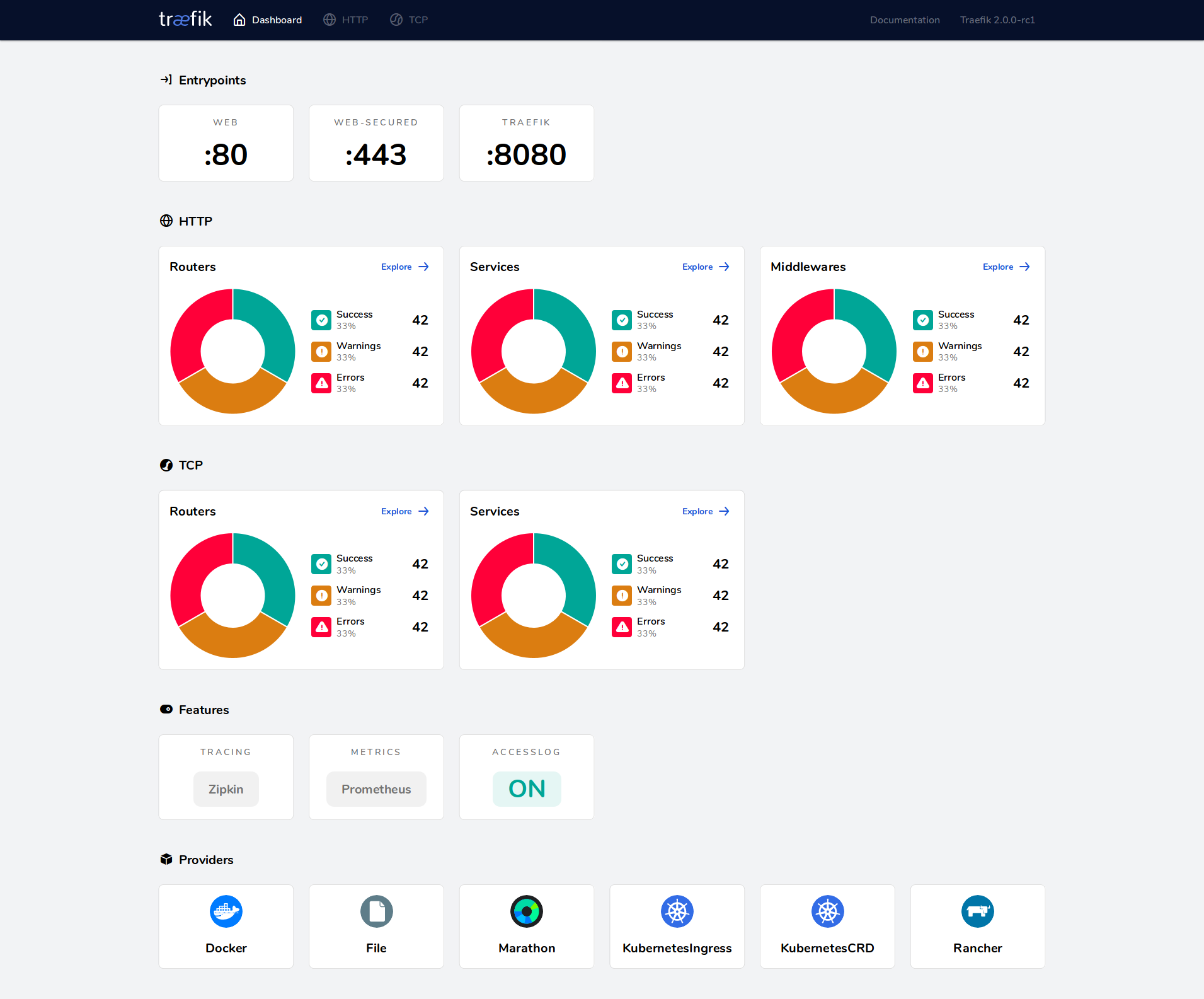The Dashboard¶
See What's Going On
The dashboard is the central place that shows you the current active routes handled by Traefik.

The dashboard is available at the same location as the API but on the path /dashboard/ by default.
The trailing slash / in /dashboard/ is mandatory
There are 2 ways to configure and access the dashboard:
There is also a redirect of the path / to the path /dashboard/,
but one should not rely on that property as it is bound to change,
and it might make for confusing routing rules anyway.
Secure Mode¶
This is the recommended method.
Start by enabling the dashboard by using the following option from Traefik's API on the static configuration:
api:
# Dashboard
#
# Optional
# Default: true
#
dashboard: true[api]
# Dashboard
#
# Optional
# Default: true
#
dashboard = true# Dashboard
#
# Optional
# Default: true
#
--api.dashboard=trueThen define a routing configuration on Traefik itself,
with a router attached to the service api@internal in the
dynamic configuration,
to allow defining:
-
One or more security features through middlewares like authentication (basicAuth, digestAuth, forwardAuth) or whitelisting.
-
A router rule for accessing the dashboard, through Traefik itself (sometimes referred to as "Traefik-ception").
Dashboard Router Rule¶
As underlined in the documentation for the api.dashboard option,
the router rule defined for Traefik must match
the path prefixes /api and /dashboard.
We recommend using a "Host Based rule" as Host(`traefik.example.com`) to match everything on the host domain,
or to make sure that the defined rule captures both prefixes:
# The dashboard can be accessed on http://traefik.example.com/dashboard/
rule = "Host(`traefik.example.com`)"# The dashboard can be accessed on http://example.com/dashboard/ or http://traefik.example.com/dashboard/
rule = "PathPrefix(`/api`, `/dashboard`)"# The dashboard can be accessed on http://traefik.example.com/dashboard/
rule = "Host(`traefik.example.com`) && PathPrefix(`/api`, `/dashboard`)"Dashboard Dynamic Configuration Examples
# Dynamic Configuration
labels:
- "traefik.http.routers.dashboard.rule=Host(`traefik.example.com`) && (PathPrefix(`/api`) || PathPrefix(`/dashboard`))"
- "traefik.http.routers.dashboard.service=api@internal"
- "traefik.http.routers.dashboard.middlewares=auth"
- "traefik.http.middlewares.auth.basicauth.users=test:$$apr1$$H6uskkkW$$IgXLP6ewTrSuBkTrqE8wj/,test2:$$apr1$$d9hr9HBB$$4HxwgUir3HP4EsggP/QNo0"# Dynamic Configuration
deploy:
labels:
- "traefik.http.routers.dashboard.rule=Host(`traefik.example.com`) && (PathPrefix(`/api`) || PathPrefix(`/dashboard`))"
- "traefik.http.routers.dashboard.service=api@internal"
- "traefik.http.routers.dashboard.middlewares=auth"
- "traefik.http.middlewares.auth.basicauth.users=test:$$apr1$$H6uskkkW$$IgXLP6ewTrSuBkTrqE8wj/,test2:$$apr1$$d9hr9HBB$$4HxwgUir3HP4EsggP/QNo0"
# Dummy service for Swarm port detection. The port can be any valid integer value.
- "traefik.http.services.dummy-svc.loadbalancer.server.port=9999"apiVersion: traefik.io/v1alpha1
kind: IngressRoute
metadata:
name: traefik-dashboard
spec:
routes:
- match: Host(`traefik.example.com`) && (PathPrefix(`/api`) || PathPrefix(`/dashboard`))
kind: Rule
services:
- name: api@internal
kind: TraefikService
middlewares:
- name: auth
---
apiVersion: traefik.io/v1alpha1
kind: Middleware
metadata:
name: auth
spec:
basicAuth:
secret: secretName # Kubernetes secret named "secretName"# Dynamic Configuration
- "traefik.http.routers.dashboard.rule=Host(`traefik.example.com`) && (PathPrefix(`/api`) || PathPrefix(`/dashboard`))"
- "traefik.http.routers.dashboard.service=api@internal"
- "traefik.http.routers.dashboard.middlewares=auth"
- "traefik.http.middlewares.auth.basicauth.users=test:$$apr1$$H6uskkkW$$IgXLP6ewTrSuBkTrqE8wj/,test2:$$apr1$$d9hr9HBB$$4HxwgUir3HP4EsggP/QNo0""labels": {
"traefik.http.routers.dashboard.rule": "Host(`traefik.example.com`) && (PathPrefix(`/api`) || PathPrefix(`/dashboard`))",
"traefik.http.routers.dashboard.service": "api@internal",
"traefik.http.routers.dashboard.middlewares": "auth",
"traefik.http.middlewares.auth.basicauth.users": "test:$$apr1$$H6uskkkW$$IgXLP6ewTrSuBkTrqE8wj/,test2:$$apr1$$d9hr9HBB$$4HxwgUir3HP4EsggP/QNo0"
}# Dynamic Configuration
labels:
- "traefik.http.routers.dashboard.rule=Host(`traefik.example.com`) && (PathPrefix(`/api`) || PathPrefix(`/dashboard`))"
- "traefik.http.routers.dashboard.service=api@internal"
- "traefik.http.routers.dashboard.middlewares=auth"
- "traefik.http.middlewares.auth.basicauth.users=test:$$apr1$$H6uskkkW$$IgXLP6ewTrSuBkTrqE8wj/,test2:$$apr1$$d9hr9HBB$$4HxwgUir3HP4EsggP/QNo0"# Dynamic Configuration
http:
routers:
dashboard:
rule: Host(`traefik.example.com`) && (PathPrefix(`/api`) || PathPrefix(`/dashboard`))
service: api@internal
middlewares:
- auth
middlewares:
auth:
basicAuth:
users:
- "test:$apr1$H6uskkkW$IgXLP6ewTrSuBkTrqE8wj/"
- "test2:$apr1$d9hr9HBB$4HxwgUir3HP4EsggP/QNo0"# Dynamic Configuration
[http.routers.my-api]
rule = "Host(`traefik.example.com`) && (PathPrefix(`/api`) || PathPrefix(`/dashboard`))"
service = "api@internal"
middlewares = ["auth"]
[http.middlewares.auth.basicAuth]
users = [
"test:$apr1$H6uskkkW$IgXLP6ewTrSuBkTrqE8wj/",
"test2:$apr1$d9hr9HBB$4HxwgUir3HP4EsggP/QNo0",
]Insecure Mode¶
This mode is not recommended because it does not allow the use of security features.
To enable the "insecure mode", use the following options from Traefik's API:
api:
dashboard: true
insecure: true[api]
dashboard = true
insecure = true--api.dashboard=true --api.insecure=trueYou can now access the dashboard on the port 8080 of the Traefik instance,
at the following URL: http://<Traefik IP>:8080/dashboard/ (trailing slash is mandatory).
Using Traefik for Business Applications?
If you are using Traefik in your organization, consider our enterprise-grade solutions:
- API Management
Explore // Watch Demo Video - API Gateway
Explore // Watch Demo Video - Ingress Controller
Kubernetes // Docker Swarm
These tools help businesses discover, deploy, secure, and manage microservices and APIs easily, at scale, across any environment.